
Find that value of $R$ for which the net resistance of the circuit is 18 ohms.
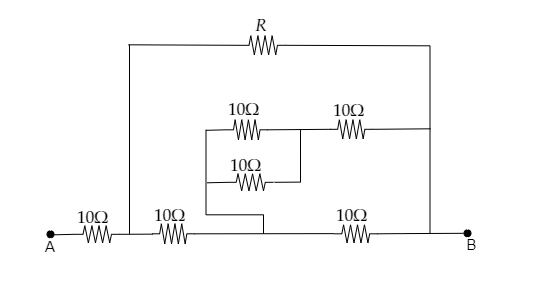
A) $8\Omega $
B) $10\Omega $
C) $16\Omega $
D) $24\Omega $
Answer
216.3k+ views
Hint: The value of the resistance $R$ can be obtained by reducing the circuit. The resistance of two resistors in series will be the sum of their resistances and the resistance of two resistors connected in parallel will be the sum of the reciprocal of their resistances.
Formula Used:
1) The effective resistance of two resistors in series is given by, ${R_{eff}} = {R_1} + {R_2}$ where ${R_1}$ and ${R_2}$ are the resistances of the two resistors.
2) The effective resistance of two resistors in parallel is given by, ${R_{eff}} = \dfrac{{{R_1}{R_2}}}{{{R_1} + {R_2}}}$ where ${R_1}$ and ${R_2}$ are the resistances of the two resistors.
Complete step by step answer:
Step 1: Sketch the arrangement of the resistors and mark each junction.
In the above figure, the point of contact between two resistors is marked.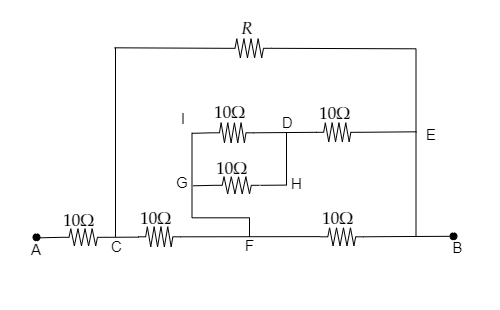
The net resistance of the above circuit is given to be ${R_{net}} = 18\Omega $
Step 2: Reduce loop IDHG.
In the loop IDHG, the two resistors are connected in parallel. Then the two resistors can be replaced by their effective resistance given by, ${R_{eff}} = \dfrac{{{R_{ID}}{R_{GH}}}}{{{R_{ID}} + {R_{GH}}}} = \dfrac{{10 \times 10}}{{10 + 10}} = 5\Omega $
Then the reduced circuit is given below.

Step 3: Reduce the resistors connected across ID and DE.
The two resistors connected across ID and DE are in series. So these resistors can be replaced by their effective resistance given by, ${R_{eff}} = {R_{ID}} + {R_{DE}} = 5 + 10 = 15\Omega $
Then the reduced circuit is given below.
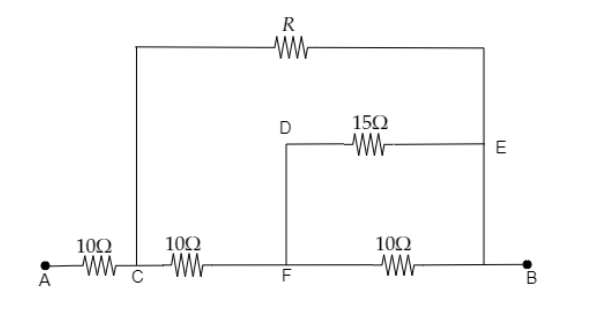
Step 4: Reduce the circuit for the resistors in the loop DEFB.
The two resistors connect across DE and FB are connected in parallel and hence they are replaced by their effective resistance given by, ${R_{eff}} = \dfrac{{{R_{DE}}{R_{FB}}}}{{{R_{DE}} + {R_{FB}}}} = \dfrac{{15 \times 10}}{{15 + 10}} = 6\Omega $
The reduced circuit is given below.
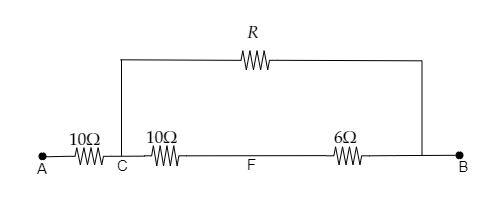
Step 5: Reduce the resistors connected across CF and FB.
The two resistors connected across CF and FB are in series. So these resistors can be replaced by their effective resistance given by, ${R_{eff}} = {R_{CF}} + {R_{FB}} = 10 + 6 = 16\Omega $
Then the reduced circuit is given below.
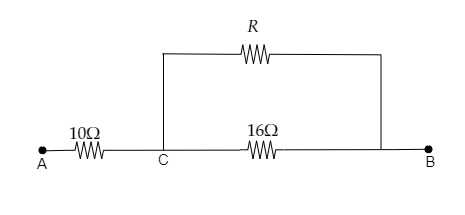
Step 6: Reduce the circuit for the resistors connected across CB.
The two resistors connect across CB are connected in parallel and hence they are replaced by their effective resistance given by, ${R_{eff}} = \dfrac{{16R}}{{R + 16}}\Omega $
The reduced circuit is given below.
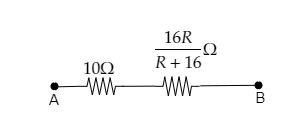
Now the net resistance will be the sum of the above two resistances as they are connected in series.
i.e., ${R_{net}} = 10 + \dfrac{{16R}}{{R + 16}} = 18\Omega $
$ \Rightarrow \dfrac{{16R}}{{R + 16}} = 8$
On cross-multiplying we get, $16R = 8R + 128$
$ \Rightarrow R = 16\Omega $
Thus the value of the resistance is $R = 16\Omega $ .
Hence the correct option is C.
Note: Two resistors are said to be connected in parallel if both of their ends are connected to each other. This type of connection is first observed in the loop IDHG. In this loop, both the resistors have the same value of resistance and so the effective resistance of that loop can also be obtained as ${R_{eff}} = \dfrac{{{R_{ID}}}}{2} = \dfrac{{10}}{2} = 5\Omega $ or ${R_{eff}} = \dfrac{{{R_{GH}}}}{2} = \dfrac{{10}}{2} = 5\Omega $. Two resistors are said to be connected in series if one of their ends is connected together.
Formula Used:
1) The effective resistance of two resistors in series is given by, ${R_{eff}} = {R_1} + {R_2}$ where ${R_1}$ and ${R_2}$ are the resistances of the two resistors.
2) The effective resistance of two resistors in parallel is given by, ${R_{eff}} = \dfrac{{{R_1}{R_2}}}{{{R_1} + {R_2}}}$ where ${R_1}$ and ${R_2}$ are the resistances of the two resistors.
Complete step by step answer:
Step 1: Sketch the arrangement of the resistors and mark each junction.
In the above figure, the point of contact between two resistors is marked.

The net resistance of the above circuit is given to be ${R_{net}} = 18\Omega $
Step 2: Reduce loop IDHG.
In the loop IDHG, the two resistors are connected in parallel. Then the two resistors can be replaced by their effective resistance given by, ${R_{eff}} = \dfrac{{{R_{ID}}{R_{GH}}}}{{{R_{ID}} + {R_{GH}}}} = \dfrac{{10 \times 10}}{{10 + 10}} = 5\Omega $
Then the reduced circuit is given below.

Step 3: Reduce the resistors connected across ID and DE.
The two resistors connected across ID and DE are in series. So these resistors can be replaced by their effective resistance given by, ${R_{eff}} = {R_{ID}} + {R_{DE}} = 5 + 10 = 15\Omega $
Then the reduced circuit is given below.

Step 4: Reduce the circuit for the resistors in the loop DEFB.
The two resistors connect across DE and FB are connected in parallel and hence they are replaced by their effective resistance given by, ${R_{eff}} = \dfrac{{{R_{DE}}{R_{FB}}}}{{{R_{DE}} + {R_{FB}}}} = \dfrac{{15 \times 10}}{{15 + 10}} = 6\Omega $
The reduced circuit is given below.

Step 5: Reduce the resistors connected across CF and FB.
The two resistors connected across CF and FB are in series. So these resistors can be replaced by their effective resistance given by, ${R_{eff}} = {R_{CF}} + {R_{FB}} = 10 + 6 = 16\Omega $
Then the reduced circuit is given below.

Step 6: Reduce the circuit for the resistors connected across CB.
The two resistors connect across CB are connected in parallel and hence they are replaced by their effective resistance given by, ${R_{eff}} = \dfrac{{16R}}{{R + 16}}\Omega $
The reduced circuit is given below.

Now the net resistance will be the sum of the above two resistances as they are connected in series.
i.e., ${R_{net}} = 10 + \dfrac{{16R}}{{R + 16}} = 18\Omega $
$ \Rightarrow \dfrac{{16R}}{{R + 16}} = 8$
On cross-multiplying we get, $16R = 8R + 128$
$ \Rightarrow R = 16\Omega $
Thus the value of the resistance is $R = 16\Omega $ .
Hence the correct option is C.
Note: Two resistors are said to be connected in parallel if both of their ends are connected to each other. This type of connection is first observed in the loop IDHG. In this loop, both the resistors have the same value of resistance and so the effective resistance of that loop can also be obtained as ${R_{eff}} = \dfrac{{{R_{ID}}}}{2} = \dfrac{{10}}{2} = 5\Omega $ or ${R_{eff}} = \dfrac{{{R_{GH}}}}{2} = \dfrac{{10}}{2} = 5\Omega $. Two resistors are said to be connected in series if one of their ends is connected together.
Recently Updated Pages
Wheatstone Bridge Explained: Working, Formula & Uses

Young’s Double Slit Experiment Derivation Explained

JEE Atomic Structure and Chemical Bonding important Concepts and Tips

JEE Amino Acids and Peptides Important Concepts and Tips for Exam Preparation

Electricity and Magnetism Explained: Key Concepts & Applications

Chemical Properties of Hydrogen - Important Concepts for JEE Exam Preparation

Trending doubts
JEE Main 2026: Application Form Open, Exam Dates, Syllabus, Eligibility & Question Papers

Derivation of Equation of Trajectory Explained for Students

Hybridisation in Chemistry – Concept, Types & Applications

Understanding the Angle of Deviation in a Prism

Understanding Collisions: Types and Examples for Students

How to Convert a Galvanometer into an Ammeter or Voltmeter

Other Pages
JEE Advanced Marks vs Ranks 2025: Understanding Category-wise Qualifying Marks and Previous Year Cut-offs

Understanding Atomic Structure for Beginners

Ideal and Non-Ideal Solutions Explained for Class 12 Chemistry

Degree of Dissociation: Meaning, Formula, Calculation & Uses

Understanding Electromagnetic Waves and Their Importance

Understanding the Electric Field of a Uniformly Charged Ring




